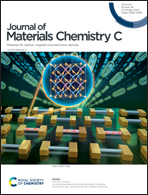Facile synthesis, formation mechanism and thermochromic properties of W-doped VO2(M) nanoparticles for smart window applications†
Abstract
Monoclinic VO2(M) has been considered as one of the most promising materials for fabricating energy-saving smart windows, but its scalable synthesis is still a great challenge. In this work, pure and tungsten (W)-doped VO2(M) nanoparticles (20–50 nm) were prepared by a simple hydrothermal recrystallization method using an amorphous precursor obtained from coprecipitation in a mixed VOSO4 and NaOH solution (pH = 9). The phase transition temperature of the obtained W-doped VO2(M) nanoparticles decreases with increasing W-doping, by −28.4 °C per at% of W in the range of 0–1.1 at%. The mechanism of hydrothermal recrystallization was studied by using ex situ powder X-ray diffraction (PXRD) and in situ synchrotron radiation-based PXRD. It was found that the hydrothermal synthesis underwent two steps: (1) recrystallization of amorphous precursor to VO2(B) crystals, and (2) allotropic phase transformation from the metastable intermediate VO2(B) to VO2(M). In addition, the fabricated films using VO2(M) with 0.7 at% W-doping showed excellent thermochromic performance, with a suitable phase transition temperature of 42.7 °C, high average luminance transmittance of up to 61.7%, and good solar energy modulation ability of 11.7%, making them a suitable material for efficient and low-cost energy saving smart windows.



 Please wait while we load your content...
Please wait while we load your content...